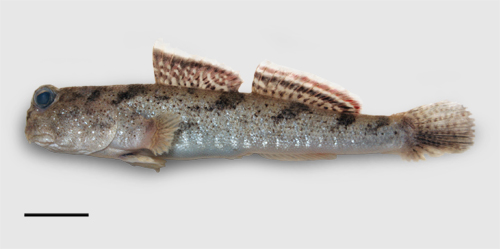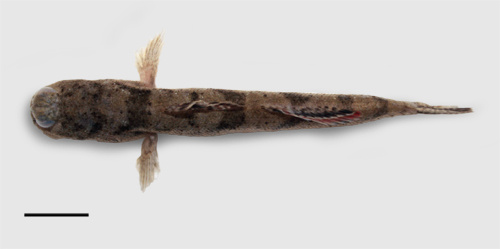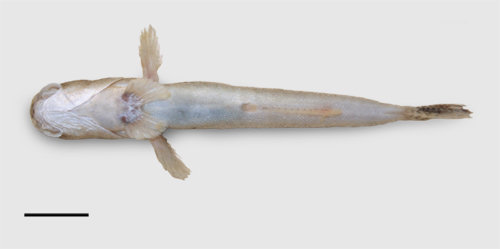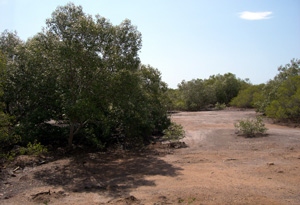Common names:
China |
Chinese Mandarin |
小弹涂鱼 (Xiao tan tu yu - Small mudskipper) |
Italy |
Italian |
perioftalmo minuto* |
Philippines |
Tagalog |
Bia |
* proposed name
|
|
|
Synonyms:
Periophthalmus minutus |
Eggert, 1935 |
(senior synonym, original combination) |
Etymology:
'Periophthalmus' is a compound name from the Greek 'peri' (around) and 'ophthalmon' (eye), which refers to the wide visual
field of these species
'minutus' means 'small' in Latin
|
Maximum recorded length:
78 mm SL (Murdy, 1989)
Live colouration (Murdy, 1989; Takita et al., 2011; pers. obs.: Australia, NT):
body ground colour light brown to reddish brown on dorsum, paler to greyish on flanks, with numerous black speckles scattered on flanks and opercula, smaller than the exposed field of the underlying scale;
7-8 irregular saddle like, diagonal, brown bars on dorsum, not reaching the lateral midline; narrow, silvery stripes may be visible on flanks, ventrally more evident; venter white.
D1 variable, complex in some variants: background brownish red with numerous white spots which can coalesce into a mottled whitish pattern; many irregular dark brown speckles on membrane and on spines, an inframarginal dark brown stripe, and a trasparent margin; D2 background transparent with one series of dark brown speckles on elements, a medial brown
stripe, an inframarginal red stripe, and a transparent margin; anal fin hyaline; pectoral and caudal fins dusky, with series of brown speckles on rays, less evident on pectoral fins; pelvic fins ventrally white, dorsally dusky
along rays and proximally dark grey
Colouration on preservation (Murdy, 1989):
ground colour yellowish brown; saddle-like dorsal bars may be visible; venter paler; scattered black speckles on flanks, smaller than the exposed field of the underlying scale. D1 light brown, with white spots and transparent margin; D2 background transparent, with a brown medial stripe and brown speckles proximally on elements; anal fin hyaline; pectoral fins dusky; caudal fin pale brown with series of brown speckles on rays; pelvic fins as in vivo
Diagnosis (Murdy, 1989):
total elements of D1 10-17; total elements of D2 11-13;
total anal fin elements 11-12;
TRDB 16-19; longitudinal scale count 62-78; length of anal fin base 15.7-19.3%SL; length of D2 base 20.1-22.7%SL; length of pelvic fins 11.6-14.8%SL; head width 14.2-18.9%SL; scattered black tiny speckles on flanks; D1 with an inframarginal dark stripe and speckles; D2 with a single brown medial stripe; dorsal fins not connected by membrane; anal fin hyaline, with no spots or stripes; pelvic fins with no frenum and with only a thin remnant of basal membrane along inner pelvic rays.
The genus is yet undefined by synapomorphies
Diet (pers. obs.: Australia, NT):
carnivorous, opportunistic (crustaceans, small invertebrates, etc.); no published study is available
Reproduction:
the details of its reproductive
cycle have not been described in literature: it probably follows the general model proposed for all
the congeneric species (see also Reproductive behaviour); no published study is available
|
|
Ecological notes (Takita et al., 2011; pers. obs.: Australia, NT):
locally abundant in mangrove forests in the high supratidal zone (Milward, 1974; Nursall,
1981), even in stunted mangrove forests adjacent
to salt flats; in these conditions, the water inside the burrows can reach extreme salinity levels (up to 75 ppt; Itoki et al., 2012)
left: Vestey's Creek, Darwin, Australia NT: small creek in an arid zone;
here this species is abundant
right:
Ludmilla Creek, Darwin, Australia NT: a small mangrove forest of Avicennia marina, separated from the sea by a sand dune and adjacent to a salt flat, in the high supratidal zone;
here P. minutus is the only species present
(photos: A. Sacchetti, 2007, with permission)
|
|
|
|
|
Distribution:
a broad range including Andaman Sea, Thailand, Java, Philippines, and Australia (Queensland and Northern Territory); type locality: Sumatra, Indonesia
(Murdy, 1989; pers. obs.)
|
|
Remarks:
the species cited in Nursall (1981; "red-fin" Periophthalmus) might be P. minutus. Nonetheless, a photo from Nursall (unpubl. mat.: photo H) shows quite a different morphology and colouration from specimens from the Northern Territory. I never examined specimens from Queensland.
|
Photographs of Periophthalmus minutus:
|
A: a comparison between P. argentilineatus (above) and P. minutus (below), from the same site; note the considerable similarity of colouration patterns; nonetheless, P. minutus has dark speckles on flanks, a different pattern on D1, a proportionally larger head, and a shorter caudal fin
(photo: G. Polgar; Buffalo Creek, Northern Territory, Australia, 2007); B: a burrow with only a shallow rim around the main opening; note the fish's head inside, and the coarse sediment's granulometry (photo: A. Sacchetti; Ludmilla Creek, Darwin, Northern Territory, Australia, 2007)*; C: a turreted burrow nearby a creek at low tide: the substrate is dry and compacted (photo: G. Polgar; Vestey's Creek, Darwin, Northern Territory, Australia,
2007); D, E : close-ups of P. minutus found nearby a sand dune (photo: G. Polgar; Ludmilla Creek, Darwin, Northern Territory, Australia, 2007); F: an aggressive fin-display (photo: G. Polgar; Buffalo Creek, Northern Territory, Australia, 2007); G: another close-up in a shallow inlet nearby a sand dune (photo: G. Polgar; Ludmilla Creek, Darwin, Northern Territory, Australia, 2007);
H: a close-up in aquarium of the "red fin" Periophthalmus from Queensland, studied by Nursall; note the different colouration pattern of dorsal fins (photo: J. Nursall; Townsvlle, Queensland, Australia); I: a close-up in aquarium of a specimen from the Northern Territory (photo: G. Polgar; Buffalo Creek, Northern Territory, Australia, 2007); J-L: other close-ups of specimens in aquarium: note the striking variation in the colouration, probably induced by different illumination conditions (photo: G. Polgar; Ludmilla Creek, Darwin, Northern Territory, Australia, 2007) * with permission
|
Drawings of Periophthalmus minutus:
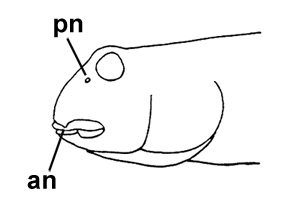
cephalic sensory and nasal pores of Periophthalmus spp.: an= anterior nostril; pn= posterior
nostril (modified from Murdy, 1989)* - * with permission
|




